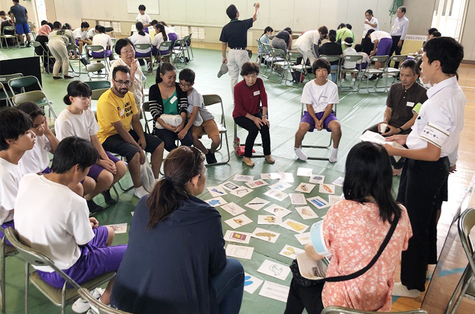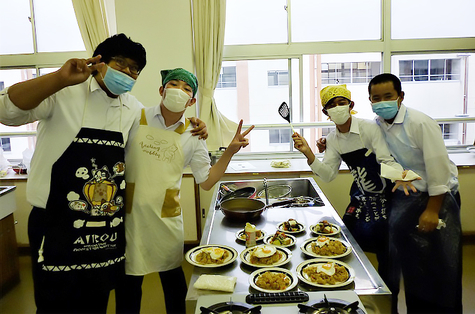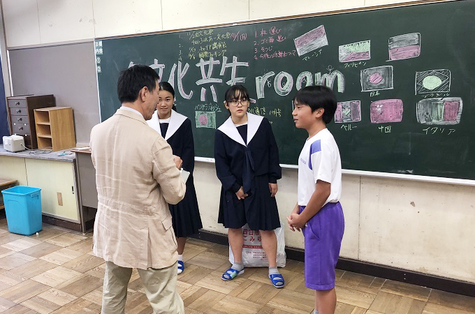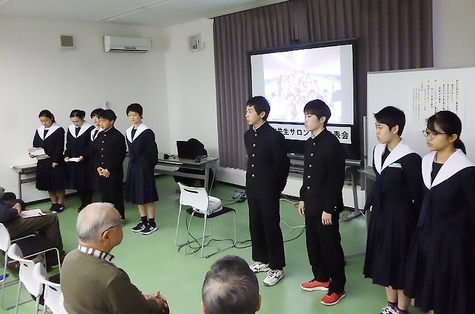
Interview with the Recipient of the 2019
Japan Foundation Prizes for Global Citizenship
From Communities to the World: Initiatives to Connect People <1>
November 13, 2020
Many organizations engage in international cultural exchange programs throughout Japan with the aim of promoting community development through arts and culture, building multicultural society and promoting international mutual understanding. Established in 1985, the Japan Foundation Prizes for Global Citizenship is intended to support organizations that endeavor to strengthen ties and networks among citizens both inside and outside Japan and share the knowledge, ideas and expertise through intercultural exchange.
One of the recipient organizations of the 2019 Japan Foundation Prizes for Global Citizenship was the Multicultural Coexistence Circle of Yokkaichi City Nishi Sasagawa Junior High School (Yokkaichi City, Mie Prefecture). We asked Sato Toshifumi, the supervising teacher of the circle, about how the circle engages in the community and carries out activities at the school. He also shared his thoughts on multicultural coexistence.
Multicultural Coexistence Circle of Yokkaichi City Nishi Sasagawa Junior High School
ーConsider Issues as Opportunities and Have the Courage to Take One Step Forwardー
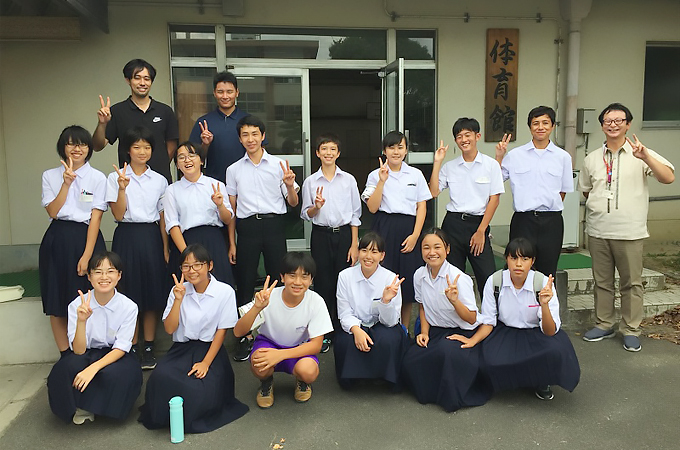
The Multicultural Coexistence Circle of Yokkaichi City Nishi Sasagawa Junior High School promotes education on multicultural coexistence in Yokkaichi City, home to numerous foreign nationals (Mr. Sato on far right).
First of all, can you tell us about the purpose of the activities of the Multicultural Coexistence Circle?
The Multicultural Coexistence Circle of Yokkaichi City Nishi Sasagawa Junior High School was launched to undertake proactive and voluntary activities outside existing frameworks of school grade-levels, club activities and the student council. Its purpose is to promote education on multicultural coexistence within the school district, which is home to a large concentration of foreign national residents.
Our school district faces various challenging issues such as diversification of language and culture, declining birthrates and an aging and shrinking population. Under these circumstances, we aim to be established as a school that helps and grows together with the community. Also, by participating in community events and activities, we encourage our students to think about and take action for solving community issues and vitalizing the region starting from a young age. In FY2020, the circle started out with 10 members (seventh- and eighth-grade students only) and three supervising teachers.
In this circle, we mainly raise awareness on multicultural coexistence through our involvement with the community. Every year, we hold a panel discussion as part of a schoolwide event for considering community contributions, multicultural coexistence and careers. Circle members serve as moderators and panelists representing the school (FY2020 event is scheduled for November 14, 2020). In addition, high school and university students as well as working adults who have graduated from our school serve as panelists and engage in discussions on various themes. Other students listen to the discussions and then participate in group talks and ask questions. In 2019, discussions focused on what students wish to value in making career choices and on what they will devote their efforts toward to fulfil their dreams.
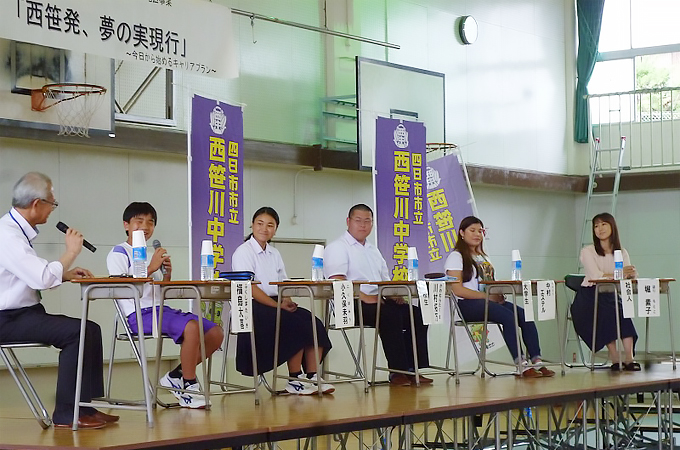
Every year lively discussions are held at the panel discussion.
From FY2018, we have also been holding lectures by guest teachers from the community as a preliminary learning event in advance of the panel discussion. This serves as an opportunity to hear directly about the need for the contribution of young people and coexistence with foreign national residents in future society and community activities, as well as the expectations of junior high school students as a source of vitality in the community. This event has spurred increased interest in the community and careers.
Since 2017, we have operated a "yo-yo fishing" booth at the Sasagawa Fureai Summer Festival (held every August), which is attended by local residents. The aim is to acquaint foreign nationals with Japan's traditional night stalls that date back to ancient times. The booth is being well received as one of the few shops for small children.
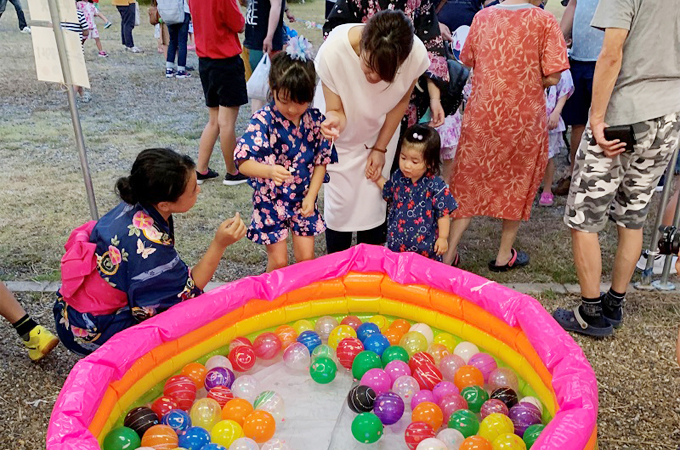
The "yo-yo fishing" booth at the Sasagawa Fureai Summer Festival is highly popular with foreign national residents and small children.
In autumn, the circle participates as staff at the Disaster Prevention Seminar (canceled in FY2020), an event coordinated by the community, disaster prevention organizations and Yokkaichi City's Multicultural Coexistence Promotion Office. This event aims to transcend nationality and promote a deeper understanding among more people of "self-help," "mutual assistance" and "public assistance" in times of disaster. On the day of this seminar, the circle runs various events such as the Disaster Prevention Maze, where participants can learn how to evacuate while keeping a low posture in case of a fire and to place a yellow cloth at a front door to signal the rescue squad that no search or rescue is needed. It also holds the Emergency Takeout Item Quiz for discussing items to bring in an emergency rescue using picture cards. Aside from these, we moderate and make presentations at group discussions and carry out PR activities by visiting nursery schools and kindergartens to introduce events and invite children and their parents to participate.
The circle also holds International Cooking, an annual event for cooking and eating foods from a variety of countries. This event raises students' interest in foreign countries and helps recruit new members. To the present, the event has been held four times and has featured Brazilian, Korean, Mexican and Indonesian cuisine. The circle reports on these activities on three occasions, namely at the school's cultural festival, at the community cultural festival and at the presentation of the city's multicultural coexistence salon.
Among the circle's activities, the panel discussion and Disaster Prevention Seminar dually serve as a Community-Building Junior Supporter Training Course that aims to encourage the participation of junior high school students in community activities and to vitalize the local community. To build a community where all residents can live with peace of mind, we hope the participation of junior high school students in community activities will prompt even more people to come forward and take part in such activities as well. Participants are certified as "junior supporters" of the city after completing the training course held by the Multicultural Coexistence Promotion Office.
What types of positive effects do the activities of the student-led circle have on the community?
The bonds between local residents and the school are stronger thanks to opportunities to interact directly with local residents at the summer festival and Disaster Prevention Seminar. In the Sasagawa school district, which is facing continued declining birthrates and an aging population, various event leaders are also getting older and many people are thus welcoming the participation of young people. The participation in this circle has served as an impetus for the school's graduates to set up booths at the summer festival and participate in picking up garbage, leading to continuous community engagement.
In the Disaster Prevention Seminar, multilingual circle members sometimes explain and give guidance to foreign national residents. This presented to the community dependable junior school students committed to the Sasagawa school district. As part of the circle's activities, members also visit nursery schools, kindergartens and elementary schools, thereby playing a role of connecting the community, schools and preschools.
We received many favorable comments about these events, such as "I'm glad that junior high school students participate in community events," "These kids are a model for multicultural coexistence in the community" and "Seeing their participation in community events, my expectations of junior high school students became higher." With greater attention placed on these activities by numerous media, the circle's activities also enabled the school and the community to gain the spotlight.
How are the students changing and growing through these activities?
Involvement in circle activities is a means for many students to raise their self-esteem and gain self-confidence. Some students in the Multicultural Coexistence Circle are unable to play active roles in learning and club activities in the way they wish. Being told "thank you" when participating in community activities, making presentations before large audiences and being interviewed by newspapers and TV are new experiences for these students, which in turn spur a sense of accomplishment and confidence.
When the new school year starts, the number of students wishing to join the circle is usually low. However, as they hold various activities and presentations, more students want to join because they "became interested after learning about activities through a presentation" or "wanted to join after watching the circle members having so much fun." It is clearly evident that circle members enjoy these activities and acquire a sense of fulfillment. Even after students graduate, they can now be seen continuing their involvement with the school and the community by speaking to current students as discussion panelists and starting up new booths at the summer festival. This is also probably because the activities of the Multicultural Coexistence Circle have resulted in increased self-initiative and interest in community contributions and multicultural coexistence.
Are there any difficulties or needed measures for ensuring the continuation of these activities? What is your advice to people carrying out activities related to multicultural coexistence?
The Multicultural Coexistence Circle is unique to our school and is an optional educational activity. With the wave of work style reforms sweeping the school, we are faced with reduced working hours and re-evaluations of work tasks. Under this situation, I believe the circle activities are in a very precarious position. We need to strongly communicate to school administrators and parents that these activities are firmly rooted in local issues, strengthen the bonds between the community and the school , and foster the development of student self-esteem and their growing interest in multicultural coexistence. In this sense, I am grateful that interviews with the media and recently receiving the Japan Foundation Prizes for Global Citizenship have raised the attention and awareness of the importance of multicultural coexistence education.
Looking ahead, I foresee increased opportunities for schools to think about and take action on multicultural coexistence education and community contributions. This may not offer much advice, but this activity started out to seize issues as opportunities. Diversification of language and culture as well as the declining birthrate and the aging of the population are undoubtedly major issues. However, this is exactly why the participation of junior high school students in community activities is so welcomed and appreciated. Another reason is that these students are so young that they have few preconceptions about cross-cultural exchange. In addition, moving into action on issues will pave the way for the creation of a school that stands out. Moreover, both children and local residents must have expectations that their schools will voice their opinions to address community issues. In other words, the courage of school administrators to take the first step forward is probably the essential factor for enabling multicultural coexistence education.
Is COVID-19 affecting your activities in FY2020? How is the circle facing these circumstances and carrying out activities?
Among the circle's main activities, the Sasagawa Fureai Summer Festival and International Cooking were canceled. So we decided to do something else at the school. The students came up with an idea to display maps of Brazil in hallways in each floor of the school building and place stickers on the maps to introduce the hometowns of students with roots in Brazil so that Japanese students would become familiar with Brazil. Non-circle students are also enjoying the event.
Though we cannot engage in our annual activities, alternatively this is an excellent opportunity for students to come up with plans they wish to implement on their own, for example, schoolwide meetings on the theme of multicultural coexistence and international exchange as well as interchanges with other schools. As such, the supervising teachers are working out the timing for implementation and selecting schools with characteristics similar to those of our school. Together with the students, we are also producing a video by using the DVD created by the Japan Foundation to introduce our activities on the occasion of receiving this award as well as footage from the TV broadcast. It would be great if we can also implement international programs.
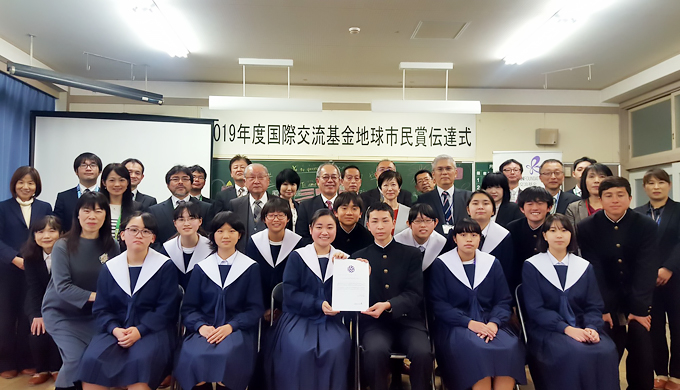
Members of the Multicultural Coexistence Circle of Yokkaichi City Nishi Sasagawa Junior High School and other involved persons at the 2019 Japan Foundation Prizes for Global Citizenship notification ceremony.
Multicultural Coexistence Circle of Yokkaichi City Nishi Sasagawa Junior High School
http://www.yokkaichi.ed.jp/~nisisasa/cms2/htdocs/?page_id=48
★Please view the video introducing the circle's activities on the Japan Foundation's official YouTube channel below.
Sato Norifumi
Junior high school Japanese language teacher. After teaching at public junior high schools and schools for Japanese outside Japan, he began teaching at Yokkaichi City Nishi Sasagwa Junior High School from 2018.
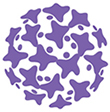
Japan Foundation Prizes for Global Citizenship
https://www.jpf.go.jp/e/about/citizen/index.html
E-mail interview and composition: Terae Hitomi and Segawa Yoko (the Japan Foundation Communication Center)
Related Articles
Related Events
Back Issues
- 2022.7.27 Beyond Disasters - T…
- 2022.6.20 Beyond Disasters - T…
- 2021.6. 7 Contributed Article …
- 2021.4.28 Crossing Borders, En…
- 2021.4.27 Contributed Article …
- 2021.4.20 Contributed Article …
- 2021.3.29 Contributed Article …
- 2020.12.22 Interview with the R…
- 2020.12.21 Interview with the R…
- 2020.11.13 Interview with the R…


